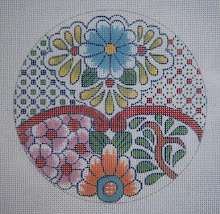 The fish is finished and free of the waste canvas. Having to use a chenille needle for this exercise has left my fingers sore - it's not an easy task pushing a needle through the stitched background with the waste canvas on top of it, and I also tend to forget that the tip is very sharp, as opposed to the tapestry needle we normally use for needlepoint.
The fish is finished and free of the waste canvas. Having to use a chenille needle for this exercise has left my fingers sore - it's not an easy task pushing a needle through the stitched background with the waste canvas on top of it, and I also tend to forget that the tip is very sharp, as opposed to the tapestry needle we normally use for needlepoint. I also had to use the needle nose pliers when the needle didn't want to pull through easily. The effect, however, is worth it. The stitches look rather rough, but it will smooth out nicely when gently steam pressed. 

I left the top fin without it's spines, as I wanted to use a long stitch for emphasis, adding them after the waste canvas was removed. That worked well, so I wish I'd left the lower fin to do that way too, as the Satin floss really shines on the stitches. A learning experience for next time. I'll probably put this away for a day or two, and then look at it with a fresh eye that isn't tired.
By stitching this pattern element on waste canvas, I made it kind of float on top of the background instead of being part of it - very effective!

3 comments:
CUTE! Lovely - beautiful! And FUN! I like it a lot!!!
Your fish seems to be swimming merrily along! Like his fun colors.
Kudos! This little fish is just beautiful. Now we all have another stitching tool to add dimension to a piece - waste canvas. Thank you for allowing us to watch as you explore how it can be used.
Post a Comment